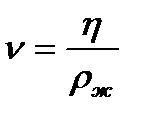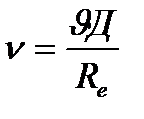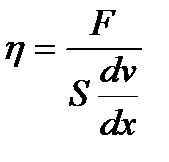Overall assessment of the knowledge 4 страница
5. 305. Reynolds number relatively to kinematic viscosity: 1. doesn’t depend on it; 2. quadratically changes; 3. exponentially changes; 4. directly proportional; 5. inversely proportional. 306. Stationary motion of a liquid: 1. layered and laminar flow; 2. turbulent flow; 3. uneven flow; 4. infinite flow; 5. vortex flow. 307. Ideal fluid is: 1. incompressible and doesn’t have viscosity; 2. incompressible and has viscosity; 3. compressible and doesn’t have viscosity; 4. compressible and fluid; 5. compressible and has viscosity. 308. Blood flow in vascular system in normal conditions: 1. has turbulent character; 2. has laminar character; 3. has turbulent and continuous character; 4. has vortex character; 5. has transient character. 309. Dynamic viscosity: A) B) C) D) E) 310. Relative viscosity: 1. 2. 3. 4. 5. 311. Kinematic viscosity: 1. 2. 3. 4. 5. 312. Unit of dynamic viscosity: 1. N/m; 2. Pa*s; 3. Pa; 4. N/m2; 5. Pa*m. 313. Viscosity of a fluid at heating: 1. increases; 2. doesn’t change; 3. decreases; 4. exponentially increases; 5. exponentially decreases; 314. Unit of relative viscosity: 1. Pa*s; 2. kg/m3; 3. N/m2; 4. m3/kg 5. nondimensional quantity. 315. SI unit of viscosity: 1. Pa*s; 2. Pa; 3. Pa*K; 4. Pa*m 5. Pa/s. 316. Viscosity of human blood in norm: 1. 4-5 mPa∙s; 2. 8-10 mPa∙s; 3. 10-15 mPa∙s; 4. 0-4 mPa∙s; 5. 0-15 mPa∙s. 317. Device used for viscosity determination: 1. calorimeter; 2. polarimeter; 3. saccharimeter; 4. viscometer; 5. microscope. 318. Viscosity of a liquid: 1. decreases with increasing of temperature; 2. increases with decreasing of pressure; 3. increases with increasing of temperature; 4. doesn’t depend on temperature; 5. doesn’t depend on pressure. 319. Part of the vascular bed that has the lowest hydraulic resistance: 1. aorta; 2. arteries; 3. arterioles; 4. capillaries; 5. veins. 320. Quantity that is reverse to fluid viscosity: 1. fluidity; 2. plasticity; 3. amorphicity; 4. elasticity; 5. density. 321. Hematocrit is: 1. part of volume in blood circulation system; 2. part of volume fell to share of red blood cells; 3. part of volume of the left ventricle; 4. part of blood stroke volume; 5. part of volume of the right ventricle. 322. Specify the dependence of viscosity on hematocrit: 1. 2. 3. 4. 5. 323. Changing of blood viscosity with increasing of hematocrit: 1. increases; 2. decreases; 3. doesn’t change; 4. exponentially decreases; 5. exponentially increases. 324. Properties of red blood cells: 1. elasticity; 2. fragility; 3. amorphicity; 4. toughness; 5. crystallinity. 325. Viscosity of blood at increasing the concentration of red blood cells: 1. decreases; 2. increases; 3. exponentially decreases; 4. linearly decreases; 5. doesn’t change. 326. Diameter of separate red blood cells: 1. 15 nm; 2. 8 µm; 3. 7 nm; 4. 3 mm; 5. 20 m. 327. Diameter of red blood cells aggregates relatively to the diameter of one red blood cell: 1. greater; 2. smaller; 3. greater in 100 times; 4. smaller in 100 times; 5. same. 328. Viscosity of blood in large vessels in norm: 1. 4-6 mPa∙s; 2. 2-3 mPa∙s; 3. 15-20 mPa∙s; 4. 1-2 kPa∙s; 5. 10-30 kPa∙s. 329. Viscosity of blood in large vessels at anemia: 1. 4-6 mPa∙s; 2. 2-3 mPa∙s; 3. 15-20 mPa∙s; 4. 1-2 kPa∙s; 5. 10-30 kPa∙s. 330. Viscosity of blood in large vessels at polycythemia: 1. 4-6 mPa∙s; 2. 2-3 mPa∙s; 3. 15-20 mPa∙s; 4. 1-2 kPa∙s; 5. 10-30 kPa∙s. 331. Decreasing of blood viscosity in capillaries: 1. Fahraeus-Lindquist effect; 2. Peltier effect; 3. Moseley’s effect; 4. Doppler effect; 5. thermoelectrical effect. 332. Sigma phenomenon: 1. increasing the viscosity in capillaries; 2. decreasing the viscosity in capillaries; 3. increasing the viscosity in large vessels; 4. decreasing the viscosity in large vessels; 5. increasing the water viscosity. 333. Hagen-Poiseuille formula: 1. heat in thermodynamic systems; 2. heat released in conductors at passing of electric current; 3. fluid density; 4. sound pressure of time; 5. volume of liquid that flows through the cross section of tube per unit of time. 334. Poiseuille formula: 1. F= 2. F=6 3. V= 4. 5. F=6 335. Stroke volume of blood: 1. amount of blood ejected by the left ventricle of heart per one systole; 2. amount of blood ejected by the left ventricle of heart per minute; 3. amount of blood ejected by the left ventricle of heart per hour; 4. amount of blood ejected by the left ventricle of heart per day; 5. amount of blood ejected by the left ventricle of heart per second; 336. Additional volume of blood entered to aorta increases the pressure within it and correspondingly dilates its walls: 1. pulse wave; 2. systolic pressure; 3. diastolic pressure; 4. volume velocity of blood flow; 5. stroke volume of blood. 337. Arterial vessels during the systole: 1. passively subside; 2. dilate; 3. their diameter doesn’t change; 4. deform irreversibly; 5. compress. 338. During the systole pressure in vessels: 1. doesn’t change; 2. increases; 3. decreases; 4. doubles; 5. exponentially increases. 339. During the diastole pressure in vessels: 1. doesn’t change; 2. increases; 3. decreases; 4. doubles; 5. exponentially increases. 340. The pressure drop in vessels depends on: 1. volume velocity of blood flow and radius of a vessel; 2. temperature and radius of a vessel; 3. radius and length of a vessel; 4. mass of a body and radius of a vessel; 5. от амплитуды и от скорости сосуда 341. Main properties of blood vessels that provide normal blood circulation: 1. elasticity, resilience; 2. plasticity, pliability; 3. amorphicity, elasticity; 4. resilience; 5. toughness. 342. Part of vascular bed that has the highest hydraulic resistance: 1. aorta; 2. arteries; 3. arterioles; 4. capillaries; 5. veins. 343.W = 8 1. hydraulic resistance; 2. pressure gradient; 3. velocity gradient; 4. circular frequency; 5. condition of fluids flow. 344. Hydraulic resistance: 1. Q=V / S 2. 8ηl /πr4 3. σ = A / S 4. h 5. V1 S1= V2 S2 T2 A2 345. Propagating in aorta and arteries wave of increased pressure caused by ejection of blood from the left ventricle in the period of systole: 1. electric wave; 2. pulse wave; 3. standing wave; 4. plane wave; 5. de Broglie wave. 346. Formula that determines the pulse wave propagation velocity through the blood vessels: 1. 2. 3. 4. 5.
347. 1. volume velocity of blood flow in elastic chamber; 2. hydraulic resistance; 3. static pressure; 4. dynamic pressure; 5. heat. 348. Device for measuring the blood pressure: 1. phonendoscope; 2. interferometer; 3. sphygmomanometer; 4. audiometer; 5. nephelometer; 349. Formula of heart work: 1. A = PV 2. A = mv2/2 3. A = PVуд + mv2/2 4. A = mgh 5. A = mc2 350. Types of muscle fibers: 1. smooth, cross-striated; 2. elastic, smooth; 3. myelinated, unmyelinated; 4. cross-striated, viscous; 5. smooth, myelinated. 351. Inside the muscular cell except known organoids contractile apparatus of the cell is located consisting of plurality parallel arranged: 1. mitochondria; 2. myofibrils; 3. sarcomeres; 4. neurilemma; 5. sarcolemma. 352. Lengths of actin and myosin filaments at the muscle contraction: 1. change; 2. don’t change; 3. double; 4. dwindle; 5. dwindle in two times. 353. Are in the composition of thick filaments in the cells of cross-striated muscles: 1. actin and myosin; 2. actin, tropomyosin, troponin; 3. actin; 4. myosin, carbohydrates; 5. myosin. 354. Are in the composition of thin filaments in the cells of cross-striated muscles: 1. actin and myosin; 2. actin, tropomyosin, troponin; 3. myofibrils, actin; 4. myosin, carbohydrates; 5. myosin. 355. Actin-myosin complex: 1. twists; 2. contributes to the further slip; 3. prevents the further slip; 4. calcinates; 5. compresses. 356. Contractile unit of muscular cell (fiber): 1. sarcomere; 2. белки актина 3. actin; 4. tropomyosin; 5. carbohydrates. 357. Device for measurement the volume of lungs: 1. spirometer; 2. spirograph; 3. pneumograph; 4. breathing pillow; 5. breathing hose. 358. External surface of the lungs: 1. diaphragm; 2. pleura; 3. spongy mass; 4. larynx; 5. alveolus. 359. Registering of electrical resistance of lungs tissues used at bronchopulmonary pathology: 1. rheopulmonography; 2. rheocardiography; 3. rheohepatography; 4. rheoencephalography; 5. rheovasography. 360. Determination of tone and elasticity of brain vessels, measurement their resistance to current of high frequency that is weak by strength and voltage: 1. rheopulmonography; 2. rheocardiography; 3. rheohepatography; 4. rheoencephalography; 5. rheovasography.
|

 D\η
D\η









 +
+ 




 d
d  /dx S
/dx S r
r  r4:
r4: = Ei - Ek
= Ei - Ek




 left part of integral:
left part of integral:


